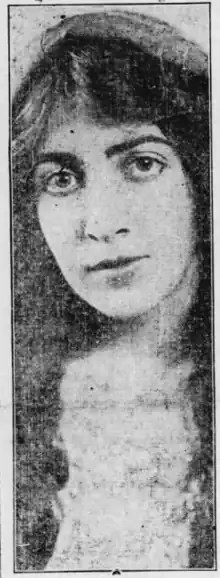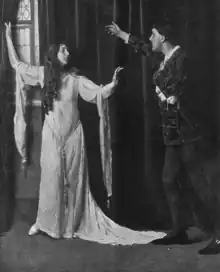

Khyva St. Albans (born Eleanor[e] Saenger; 1896-1989), also known as Zara Alexeyewa, Ayenara Alexeyeva, was an American actress, dancer, and choreographer. She was a longtime resident of Ajijic, on Lake Chapala in Mexico.
Early life
Eleanore Saenger[1] was born in New York City, although she claimed other birthplaces, including France.[2] Her parents were musicians; her mother was organist Charlotte Welles Saenger, and her father was baritone singer and voice coach Oscar Saenger.[3] Both parents supported and financed St. Albans' hopes of a theatrical career, until Oscar Saenger died in 1929.[4][5]
Stage career
St. Albans appeared in two shows on Broadway; she played Juliet opposite George Relph's Romeo in a 1915 production of Romeo and Juliet,[6] and she played a dancer in Ruth Sawyer's The Awakening (1918), costarring with Theodore Kosloff.[7] Neither show was well-reviewed; the New York Times called The Awakening "a weird and very artificial play" "almost unbelievably crude and old-fashioned."[8] Metcalfe, a writer in Life, mused that "Someday, perhaps, we shall have a Society for the Prevention of Ladies Who Think They Can Act, but Can't, [and] a League for the Suppression of Persons Who Write Plays But Shouldn't. Had either of these organizations been in successful existence we should never have had 'The Awakening' with Khyva St. Albans."[9] Of her Juliet, Heywood Broun in the New York Tribune wrote that "there was no passion in the performance of Miss St. Albans. She was a Juliet of the sort who would have suggested a long engagement, deferring marriage until such time as she had finished her schooling and Romeo had a steady job".[10]
St. Albans translated a work by Leonid Andreyev as The Painted Laugh, which she starred in and produced for the London stage in 1921. Basil Rathbone was the male lead.[11] The production became infamous when she and her mother suddenly disappeared after bad reviews for the first matinee,[12] leaving the show's backers and cast unpaid.[13][14][15][16][17] She was eventually found in a Paris hotel.[18]
From 1926 to 1927, she was co-director of ballet at the Philadelphia Grand Opera Company, with her partner, dancer Holger Alexeyev-Mehner.[19][20]
Mexico
In the 1940s, after several extended visits, St. Albans had moved to Mexico permanently, with Alexeyev-Mehner (who died in 1944). She was known as "La Rusa" in Ajijic on Lake Chapala, where she made her home.[21][22][23] An American visitor to Ajijic described her as "a ghostly figure in flowing silks and gossamer. She wore a wide-brimmed hat and held herself erect with a perfectly straight back. A long, thick rope-like braid of hair hung down to her waist."[24] Late in life, she called attention to the problem of pollution in Lake Chapala.[25][26] She died in Ajijic in 1989, aged 92 years.[22]
References
- ↑ Ancestry.com: New York, New York, U.S., Index to Birth Certificates, 1866-1909, Certificate Number 12228.
- ↑ "The Girl Who Has 'Dreamed' Joan of Arc" Courier-Journal (April 9, 1916): 53. via Newspapers.com

- ↑ Bide Dudley, "About Plays and Players" Evening World (November 12, 1915): 24. via Newspapers.com

- ↑ "The Oscar Saenger House - No. 6 East 81st Street" Daytonian in Manhattan (July 19, 2017).
- ↑ "Oscar Saenger Estate Small" New York Times (May 22, 1929): 21. via ProQuest
- ↑ "Hits on the Stage: Romeo and Juliet" Harper's Weekly (December 11, 1915): 563.
- ↑ Gerald Bordman, American Theatre: A Chronicle of Comedy and Drama 1914-1930 (OUP USA 1995): 88. ISBN 9780195090789
- ↑ "The Awakening is Crude" New York Times (October 3, 1918): 11.
- ↑ Metcalfe, "Two Comedians and a Calamity" Life (October 24, 1918): 601.
- ↑ New York Tribune (November 24, 1915)
- ↑ Amnon Kabatchnik, Blood on the Stage: Milestone Plays of Crime, Mystery, and Detection : an Annotated Repertoire, 1900-1925 (Scarecrow Press 2008): 250. ISBN 9780810861237
- ↑ "American Actress 'Blows' As London Critics Bombard" Des Moines Register (November 22, 1921): 8. via Newspapers.com

- ↑ J. P. Wearing, The London Stage 1920-1929: A Calendar of Productions, Performers, and Personnel (Rowman & Littlefield 2014): 127. ISBN 9780810893023
- ↑ "Theatre Company Left Stranded After Giving One Performance" Barrier Miner (November 21, 1921): 1. via Trove

- ↑ "Missing Actress" The Register (January 9, 1922): 3. via Trove

- ↑ "Creditors Comment on Khyva's Going" Variety (November 25, 1921): 2.
- ↑ "Scotland Yard Searches for Miss Khyva St. Albans" Brooklyn Daily Eagle (November 21, 1921): 6. via Newspapers.com

- ↑ "Found" Daily News (February 10, 1922): 15. via Newspapers.com

- ↑ Frank Hamilton, Opera in Philadelphia: Performance Chronology, 1925-1949 Archived 2012-02-06 at the Wayback Machine (2009): 36.
- ↑ Linton Martin, "Themes and Variations" Philadelphia Inquirer (May 15, 1927): 97. via Newspapers.com

- ↑ "Yanks Who Don't Go Home" Life (October 23, 1957): 159.
- 1 2 "Ajijic in the Old Days: Zara Alexeyewa, aka La Rusa" Lake Chapala Artists (February 15, 2018).
- ↑ "Letter to the Editor: Serenity in Mexico" Chicago Tribune (January 3, 1977): 44. via Newspapers.com

- ↑ Tobias Schneebaum, Secret Places: My Life in New York and New Guinea (University of Wisconsin Press 2000): 6-7. ISBN 9780299169909
- ↑ Ed Foster, "A Tale of 2 Lakes and Good-Hearted Women Who Love Them" El Paso Times (December 2, 1984): 26. via Newspapers.com

- ↑ Ed Foster, "Flamboyant Actress Devoted Efforts to Saving Lake Chapala" El Paso Times (June 4, 1984): 5. via Newspapers.com
